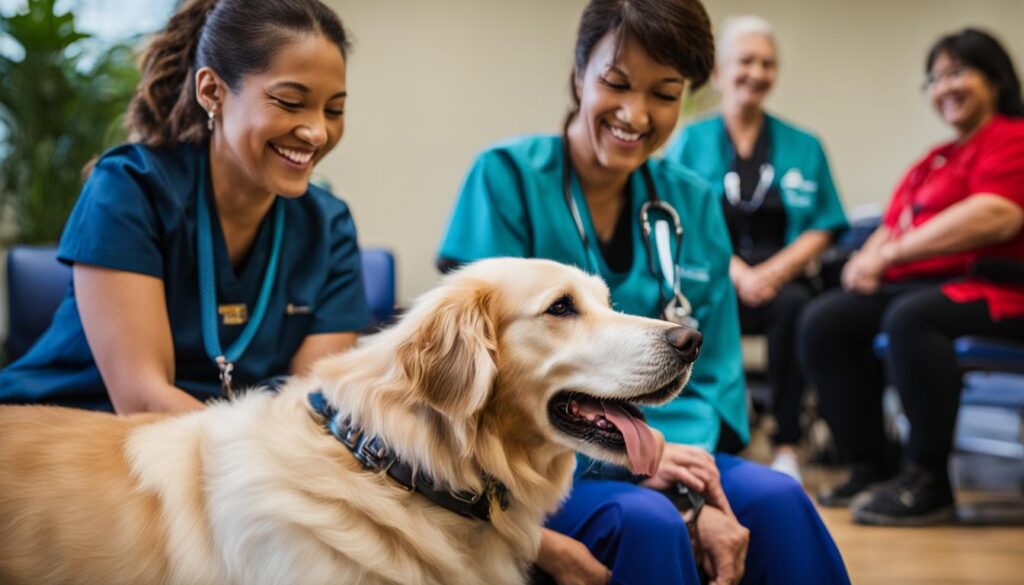Welcome to Healing Paws, where the power of therapy dogs is harnessed to provide emotional support, comfort, and healing. Founded by Christi in 1993, this program has been making a significant impact in the field of Animal-Assisted Therapy. Christi and her trusty team of therapy dogs, Bear, Paddy, and Viggo, have been working tirelessly to educate volunteers and professionals on the art of canine-assisted healing.
At Healing Paws, we believe in the power of the human-animal bond. Our registered therapy dogs, certified by Reading with Rover, have proven to be highly effective in reducing stress, anxiety, and loneliness in individuals. Rather than replacing existing therapies, our program aims to enhance them by focusing on the well-being of the whole person.
Key Takeaways:
- Therapy dogs provide emotional support, comfort, and healing.
- Healing Paws aims to educate volunteers and professionals in the community.
- Registered therapy dogs have been shown to reduce stress, anxiety, and loneliness.
- Therapy dogs enhance existing therapies rather than replacing them.
- The human-animal bond has a profound impact on mental health and well-being.
The Role of Therapy Dogs in Healing
Therapy dogs, such as those in the Healing Paws program, play a vital role in providing more than just emotional support. They are trained to perform specific tasks that aid individuals with psychiatric disabilities, helping them manage their conditions and regain independence. These extraordinary canines have the ability to sense emotions and provide comfort, reducing stress and anxiety levels. In addition to emotional support, therapy dogs promote social connection, reduce loneliness, and improve overall well-being. They have been shown to enhance the treatment experience, facilitate communication, and provide a source of joy and healing during difficult emotional times.
Studies have highlighted the positive impact of therapy dogs on individuals’ lives. According to a recent survey, 90% of individuals who interacted with therapy dogs reported reduced stress and improved mood. Dogs have a unique ability to create a calming presence and provide a sense of security, enabling individuals to open up and engage more effectively in therapy sessions. These canines have been instrumental in helping individuals with post-traumatic stress disorder (PTSD), autism spectrum disorders, and other mental health conditions. Whether it’s providing a comforting paw to hold or engaging in interactive activities, therapy dogs have proven to be invaluable companions in the healing process.
“Having a therapy dog by my side during therapy sessions has been truly transformative. The unconditional love and support that my therapy dog provides have helped me build trust, manage my anxiety, and navigate difficult emotions. It’s like having a best friend who understands me without judgment.”
Therapy dogs are carefully selected and trained to ensure they can handle various situations and environments with ease. They undergo rigorous obedience training and are socialized extensively to ensure they are comfortable around different people and settings. This training equips therapy dogs with the skills to provide comfort and support to individuals in need. Their gentle demeanor and intuitive nature make them perfect companions for those seeking solace and healing. The presence of therapy dogs in therapeutic settings offers a powerful form of intervention that promotes overall well-being and enhances the healing journey.
| Benefits of Therapy Dogs in Healing | Examples |
|---|---|
| Reduced stress and anxiety levels | Individuals feeling a sense of calm and relaxation when interacting with therapy dogs. |
| Promotion of social connection | Isolated individuals experiencing increased social interaction and connection through engaging with therapy dogs. |
| Enhanced treatment experience | Therapy sessions becoming more effective and engaging when therapy dogs are present, leading to improved outcomes. |
| Facilitated communication | Individuals feeling more comfortable and open to expressing their emotions and thoughts in the presence of therapy dogs. |
The impact of therapy dogs in healing is undeniable. Through their unconditional love, support, and unique abilities, these remarkable canines provide comfort, promote social connection, and contribute to overall well-being. The stories of therapy dogs impacting lives and providing comfort are a testament to their invaluable role in the healing process. Whether it’s a gentle nudge, a comforting paw, or a wagging tail, therapy dogs have an extraordinary talent for bringing joy and healing to those who need it most.

The Science Behind the Healing Connection
Research has shown that dogs have a profound impact on our mental health and well-being. The human-animal bond, particularly with dogs, has been observed for centuries. Dogs can improve life satisfaction, provide a sense of purpose, and boost self-esteem. Interacting with dogs has been linked to reduced risk of cardiovascular issues, lower depression levels, and fewer doctor visits. Dogs offer emotional support, comfort, and companionship, promoting physical and emotional health. Their presence in therapeutic settings can enhance the treatment experience and aid in the healing process.
The healing connection between humans and dogs goes beyond the surface level. Numerous studies have shown that the presence of dogs leads to increased release of oxytocin, a hormone associated with bonding and love, in both humans and dogs. This hormonal response helps reduce stress levels, lower blood pressure, and promote a sense of calmness and relaxation. The non-judgmental nature of dogs creates a safe space for individuals to express emotions and feel supported. The simple act of petting or cuddling a dog can release endorphins, which are natural mood boosters.
| Benefit | Explanation |
|---|---|
| Reduced Stress | Interacting with dogs can lead to a decrease in stress hormones such as cortisol, resulting in a calmer state of mind. |
| Improved Mood | The presence of dogs can stimulate the release of serotonin and dopamine, which are neurotransmitters associated with happiness and pleasure. |
| Enhanced Communication | Dogs can act as social facilitators, breaking down barriers and helping individuals engage in conversation and connect with others. |
| Promoted Physical Activity | Taking care of a dog involves regular walks and exercise, which can improve physical fitness and overall well-being. |
Overall, the science behind the healing connection between humans and dogs is a fascinating field of study. The therapeutic benefits of canine-assisted healing are well-documented and continue to be explored. Dogs in therapeutic roles provide a unique form of support and companionship that can greatly contribute to the healing process of individuals. The bond we share with our furry friends goes beyond words and has the power to uplift our spirits, provide comfort, and promote a sense of well-being.
Choosing and Training a Therapy Dog
When it comes to selecting and training a therapy dog, there are several factors to consider. Whether you are looking for a therapy dog for a program or for personal use, finding the right canine companion is essential. The success stories of therapy dogs speak volumes about the comfort and joy they bring to individuals in need of emotional support. So, how do you go about choosing and training a therapy dog?
Choosing the Right Therapy Dog
The first step in selecting a therapy dog is to look for certain traits that make them suitable for the role. Calm and stable temperament, intelligence, and a strong bond with their handler are crucial characteristics to consider. These traits ensure that the therapy dog can handle various situations and provide comfort to those in need. It’s also important to assess the dog’s compatibility with the specific population they will be working with. For example, a therapy dog working with children may require a different temperament than one working with the elderly.
Professional Training vs. Owner-Training
Once you have chosen a therapy dog, you have the option of professional training or owner-training. Professional training programs ensure that the dog receives comprehensive training and is reliable in various situations. However, these programs can be costly. On the other hand, owner-training allows for a unique bond to form between the dog and handler. It requires a significant time commitment and dedication to training. While owner-training may be more time-consuming, it can be a rewarding experience that strengthens the connection between the therapy dog and their handler.
Factors to Consider in Training Programs
When selecting a training program for your therapy dog, there are several factors to consider. Look for programs with experience and expertise in training therapy dogs. Consider their training methods and ensure they align with your goals and values. Customization is also important, as each therapy dog may have specific needs and areas of focus. Request references from previous clients to gain insight into the success of the program. Additionally, check if the training program is accredited by recognized organizations in the field.
| Factors to Consider in Choosing a Training Program | Professional Training | Owner-Training |
|---|---|---|
| Cost | May be costly | Time commitment |
| Bond with Handler | Develops over time | Strong bond from the start |
| Reliability | Highly trained and reliable dog | Dependent on consistency of training |
| Customization | Specific training for therapy work | Flexibility to focus on individual needs |
| References | Can provide references from past clients | N/A |
| Accreditation | Check for accreditation by recognized organizations | N/A |
Choosing and training a therapy dog is a journey that requires careful consideration. Whether you opt for professional training or choose to train your therapy dog yourself, the bond and impact they can have on individuals’ lives are immeasurable. With the right dog and training program, you can create a therapy dog partnership that brings comfort, support, and joy to those in need.

Table: Training Journey of a Therapy Dog
| Phase | Description |
|---|---|
| Puppy Selection | Choose a puppy with a calm and stable temperament |
| Socialization | Expose the puppy to various environments, stimuli, and interactions |
| Core Training | Teach basic obedience commands and good manners |
| Specialized Skills Training | Train the dog for specific tasks based on the needs of the clients |
| Ongoing Practice and Assessment | Continuously reinforce and assess the dog’s abilities |
The Impact of Resident Dogs in Treatment Settings
Dogs are more than just pets; they can also serve as valuable companions and sources of emotional support in treatment settings. When resident dogs are present, they provide a sense of comfort and companionship to individuals undergoing treatment. These dogs have a remarkable ability to reduce feelings of loneliness and isolation, promoting social connection and overall well-being.
The presence of resident dogs in treatment centers has been shown to have numerous benefits. For example, individuals who interact with these dogs experience reduced anxiety and improved emotional well-being. The unconditional love and non-judgmental support provided by these dogs create a safe environment for individuals to express themselves and process their emotions.
Moreover, the interaction with resident dogs can have a positive impact on physical health. Studies have shown that spending time with dogs can lower blood pressure, reduce stress levels, and even boost the immune system. These furry companions offer a unique form of therapy, helping individuals on their journey to healing and recovery.

The Benefits of Resident Dogs in Treatment Settings
| Benefit | Description |
|---|---|
| Reduced Anxiety | The presence of resident dogs helps individuals feel more relaxed and at ease, reducing anxiety levels. |
| Improved Emotional Well-being | Dogs offer emotional support, comfort, and companionship, promoting overall emotional well-being. |
| Social Connection | The interaction with dogs facilitates social connection, allowing individuals to form bonds and engage with others. |
| Physical Health Benefits | Spending time with resident dogs can lead to lower blood pressure, reduced stress levels, and improved immune function. |
The Benefits of Dog Companionship in Treatment
When it comes to therapy and emotional support, dogs have proven to be invaluable companions. Their presence in treatment settings offers comfort, grounding, and a source of joy. Dogs have a unique ability to provide emotional support, reducing stress, anxiety, and feelings of loneliness. Research has shown that interacting with dogs can have a positive impact on both physical and emotional health, promoting overall well-being.
One of the key benefits of dog companionship in a treatment setting is the reduction of stress and anxiety. Dogs have a calming effect on individuals, helping to regulate their emotions and provide comfort during challenging times. The unconditional love and support they offer can help individuals feel more grounded and supported in their healing journey.
In addition to stress reduction, dogs also promote social connection and engagement. Their friendly and approachable nature can help break down barriers and facilitate communication between individuals in treatment. Dogs provide a non-judgmental space where individuals can feel accepted and understood, fostering a sense of belonging and community.
“Dogs have a unique ability to provide emotional support, reducing stress, anxiety, and feelings of loneliness.”
Table: The Impact of Dog Companionship in Treatment
| Benefits | Examples |
|---|---|
| Stress reduction | Reduced heart rate and blood pressure, increased relaxation |
| Promotion of social connection | Increase in social interactions, improved communication |
| Enhanced well-being | Improved mood, increased sense of purpose |
Overall, the benefits of dog companionship in a treatment setting are vast. Dogs provide comfort, emotional support, and promote social connection. They have a positive impact on individuals’ physical and emotional health, helping to reduce stress and anxiety levels. Their presence enriches the treatment experience, creating a nurturing and supportive environment for healing and recovery.
Conclusion
Therapy dogs are making a tremendous impact on people’s lives, proving to be more than just furry companions. These remarkable canines have the power to heal, provide comfort, and spread joy wherever they go. Whether they serve as emotional support animals or undergo specialized training, therapy dogs have transformed the lives of countless individuals.
From the heartwarming stories of therapy dogs like Bear, Paddy, and Viggo in the Healing Paws program to the countless others making a difference, these dogs have shown us the true meaning of unconditional love and support. Their presence in therapeutic settings has enhanced the treatment experience, promoting social connection and overall well-being.
Therapy dogs play vital roles in aiding individuals with psychiatric disabilities, providing emotional support, and reducing stress and anxiety levels. They offer a unique form of therapy and support, helping people on their journey to healing and recovery. The science confirms what we’ve always known: dogs have a profound impact on our mental health and well-being.
So, as we celebrate the stories of therapy dogs and recognize their incredible contributions, let us continue to support these amazing animals and the programs that train and utilize them. Therapy dogs are truly changing lives and making the world a better place, one wagging tail at a time.
FAQ
What is Healing Paws?
Healing Paws is a program founded by Christi that utilizes therapy dogs to provide emotional support, comfort, and healing.
How long has Healing Paws been operating?
Christi and her canine associates Bear, Paddy, and Viggo have been working in the field of Animal-Assisted Therapy since 1993.
What does Healing Paws aim to achieve?
Healing Paws aims to educate volunteers and professionals on how to work with animals in the community through workshops and skills training classes.
How do therapy dogs registered with Reading with Rover help individuals?
Therapy dogs registered with Reading with Rover have proven to be effective in reducing stress, anxiety, and loneliness in individuals.
What is the focus of the Healing Paws program?
The program focuses on the well-being of the whole person and aims to enhance existing therapies rather than replace them.
What tasks can therapy dogs assist with for individuals with psychiatric disabilities?
Therapy dogs are trained to perform specific tasks that aid individuals with psychiatric disabilities, helping them manage their conditions and regain independence.
What benefits do therapy dogs provide?
Therapy dogs reduce stress and anxiety levels, promote social connection, reduce loneliness, and improve overall well-being.
What impact do dogs have on mental health?
Dogs have been shown to improve life satisfaction, provide a sense of purpose, and boost self-esteem. Interacting with dogs has also been linked to reduced risk of cardiovascular issues, lower depression levels, and fewer doctor visits.
What traits should one look for in a therapy dog?
Calm and stable temperament, intelligence, and a strong bond with their handler are important traits to look for in a therapy dog.
How can therapy dogs be trained?
Therapy dogs can be professionally trained or owner-trained, each approach having its pros and cons.
What does the training process of a therapy dog involve?
The training process includes puppy selection, socialization, and core training phases, which focus on developing a reliable and effective therapy dog.
What benefits do resident dogs in treatment settings provide?
Resident dogs in treatment settings provide companionship, comfort, emotional support, social connection, and stress relief.
How do dogs contribute to the treatment experience?
Dogs enhance the treatment experience by facilitating communication and creating a sense of joy and well-being.
What impact does dog companionship have in treatment?
Dog companionship reduces stress, anxiety, and feelings of loneliness, and promotes comfort, emotional grounding, and engagement in treatment.
What is the power of therapy dogs in healing?
Therapy dogs have the ability to transform lives, provide comfort, spread joy, enhance the treatment experience, and promote overall well-being.





